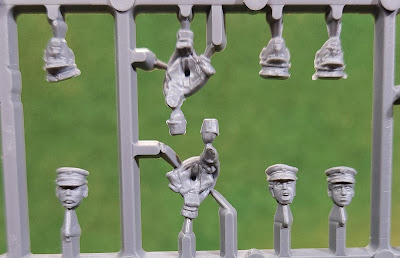front of the box,
nice artwork closely reminiscent of Rochling's "Landau Gate" painting
Thanks to the good folks at Michigan Toy Soldier forgetting me a copy of this set to review.
Prussia did not go into the Franco-Prussian War on its own, the other German Principalities joined in to help. The Kingdom of Bavaria was one of the larger contributors to the war effort, as well as being the first of the Southern German States to join in the mobilization against France. This force took part in many battles throughout the war. After the war it joined the German Empire but maintained considerable autonomy until the end of the Great War. If you want to paint a force for the Franco Prussian War and don't fancy seas of dark blue Prussians the Bavarians in their light cornflower blue and distinctive helmets would make a smaller self-contained force with a decidedly different look.
This set provides what would be the bulk of the fighting troops in the form of Line Infantry and Jagers; twenty-eight Infantry soldiers, four command officers and eight Jagers. The miniatures are cast in a medium gray medium hard plastic with no trace of flash and only a hint of mold-lines. The sculpting is up to the usual superb Perry standards with natural poses and realistic proportions enhanced by a delicate understanding of the manner in which clothing drapes over a body. This kit offers both the Raupenhelm and the forage cap as options for headgear. Also included is a set of bases and a pamphlet describing the Bavarian army, it's organization and an assembly and painting guide. The painting guide calls for a much darker blue than many sources (including a good many contemporary ones) than is usually associated with the Bavarian army over the centuries. But I am here to review the minis, not dictate on how you paint them, so on to the pictures.
back of the box, handy assembly and painting guide
box with contents
the highly informative and concise pamphlet, complete with flags
very handy tabular data on facing and cuff colors
Jager sprue, Side A
nice active poses as well as a casualty figure
Jager sprue, Side B
the backpack/rolled overcoat are cast separately to simply painting
Command sprue, Side A
excellent proportions and crisply cast
Command sprue, Side B
well done details on the drum and accoutrements
crouching Jagers, notice how the folds of the jacket and trousers
exactly match the position of the body this will make painting a much simpler task
even the tiny lion atop the flag pole gets attention
more Jagers, the poses are active without being cartoonish,
the clothing drapes naturally and the detail is sharp
the faces are first class
you can almost see the confidence (Germanic arrogance?) in the poses
if you look at the right hand figure you can see a hint of the crease in his pant-leg!
the faces of Perry Brothers mins almost look like portraits
is it me, or does the right hand face look like Joe Stalin?
the Infantry sprue, Side A
the usual Perry attention to posing and correct anatomy
infantry sprue, Side B
rifles can be carried "at the trail" or with bayonets fixed "at the ready"
a nice touch that can add variety to your units
all the poses are resolutely marching forward,
all different, but alike enough to look like a group
more faces, now I think I see Hugh Laurie in the middle of the bottom row!
accurately thin firearms and properly proportioned hands
(I hate minis with "ham-hands")
more excellent sculpting, notice how the equipment
hangs against the body, not "stuck-on" as an afterthought
A superb addition to the stable of of exemplary Perry Brothers minis. This gives the ambitious gamer a chance to affordably built the Bavarian army of the 1870s (and if you squint just a bit you could also use them for the 1866 war against Prussia). I'm sorely tempted by these.
Very Highly Recommended!





















It's not just you. That definitely looks like "Uncle Joe Stalin".
ReplyDeleteHey just an observation and follow on question from the photo montage. Those "rifles" look awfully "muskety". How much had the uniform changed from the earlier Napoleonic Era? Would these do for that time frame as well?
ReplyDeleteHousemartin, The uniform had changed substantially; by 1870 the helmet was much lower, the jacket was shorter and lacked facings , the pants were loose and gaiters were no longer worn and the greatcoat was rolled and carried across the body instead of on top of the back pack.
DeleteI agree about the quality of the sculpting and poses. However, compared to the 2 Prussian boxes, this release doesn't quite measure up. They only provide us with one type of rauppenhelm helmet, when (like the Prussians) there was an earlier helmet still in use. They give you both options with Prussians. As an alternative, supplying enough helmets to equip these figures as either jagers or line fusiliers would've have been great. Like the two French boxes, Perry is giving us a lot less for pur money.
ReplyDelete